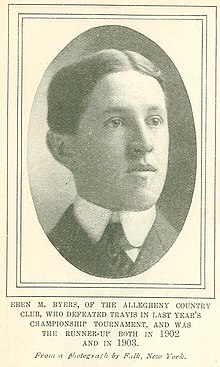Loading AI tools
American amateur golfer (1880–1932) From Wikipedia, the free encyclopedia
Ebenezer McBurney Byers (April 12, 1880 – March 31, 1932) was an American socialite, sportsman, and industrialist. He won the 1906 U.S. Amateur in golf. He died from jawbone cancer after consuming Radithor, a patent medicine made from radium salts dissolved in water.
| Eben Byers | |
|---|---|
 Byers in 1906 | |
| Personal information | |
| Full name | Ebenezer McBurney Byers |
| Born | April 12, 1880 Pittsburgh, Pennsylvania, U.S. |
| Died | March 31, 1932 (aged 51) Manhattan, New York, U.S. |
| Sporting nationality | |
| Career | |
| Status | Amateur |
| Best results in major championships (wins: 1) | |
| PGA Championship | DNP |
| U.S. Open | CUT: 1908 |
| The Open Championship | DNP |
| U.S. Amateur | Won: 1906 |
| British Amateur | T17: 1904 |

The son of industrialist Alexander Byers, Eben Byers was educated at St. Paul's School and Yale College.[1] He earned a reputation as a sportsman and played on the Yale Bulldogs golf team. Byers was the U.S. Amateur golf champion of 1905,[2] after finishing runner-up in 1902 and 1903.[3][4] Byers eventually became the chairman of the Girard Iron Company, which had been created by his father.[1]
In 1927, Byers injured his arm falling from a railway sleeping berth. For the persistent pain, a doctor suggested he take Radithor, a patent medicine manufactured by William J. A. Bailey.[5] Bailey was a Harvard University dropout who falsely claimed to be a doctor of medicine and had become rich from the sale of Radithor, a solution of radium in water which he claimed stimulated the endocrine system. He offered physicians a 1/6 kickback on each dose prescribed.[6]
Byers began taking several doses of Radithor per day, believing it gave him a "toned-up feeling", but stopped in October 1930 (after taking some 1400 doses) when that effect faded. He lost weight and had headaches, and his teeth began to fall out. In 1931, the Federal Trade Commission asked him to testify about his experience, but he was too sick to travel, so the commission sent a lawyer to take his statement at his home; the lawyer reported that Byers's "whole upper jaw, excepting two front teeth and most of his lower jaw had been removed" and that "All the remaining bone tissue of his body was disintegrating, and holes were actually forming in his skull."[7]
His death on March 31, 1932, was attributed to "radiation poisoning" using the terminology of the time, but it was due to cancers, not acute radiation syndrome.[5][8] Radium is known to emit alpha, beta, and gamma radiation. While alpha radiation has low penetrating ability and typically does not present a danger, ingestion of radium in the form of Radithor allowed accumulation in the bones. Without shielding provided by the skin, the highly ionizing alpha radiation was able to cause localized cell damage on an extreme level, and this is ultimately what led to Byers' cancer and death.[9] He is buried in Allegheny Cemetery in Pittsburgh, Pennsylvania, in a lead-lined coffin.[6]
Byers's death received much publicity and it heightened awareness of the dangers of radioactive "cures".[8]
The Federal Trade Commission issued an order against Bailey's business to "cease and desist from various representations theretofore made by them as to the therapeutic value of Radithor and from representing that the product Radithor is harmless".[10] He later founded the "Radium Institute" in New York and marketed a radioactive belt-clip, a radioactive paperweight, and a mechanism which purported to make water radioactive.[11]
After exhuming Byers's body in 1965, MIT physicist Robley Evans estimated Byers' total radium intake as about 1000 μCi (37 MBq), with about half from Ra-226 and the other half from the highly radioactive mesothorium (Ra-228).[12][failed verification] Dr. Evans also studied radium dial painters and was able to study one whose intake was similar to, but somewhat higher than Byers'.
| Year | Championship | Winning score | Runner-up |
|---|---|---|---|
| 1906 | U.S. Amateur | 2 up |
| Tournament | 1900 | 1901 | 1902 | 1903 | 1904 | 1905 | 1906 | 1907 | 1908 | 1909 |
|---|---|---|---|---|---|---|---|---|---|---|
| U.S. Open | CUT | |||||||||
| U.S. Amateur | R16 | R16 | 2 | 2 | R16 | QF | 1 | SF | QF | |
| The Amateur Championship | R32 | R128 | ||||||||
| Tournament | 1910 | 1911 | 1912 | 1913 | 1914 | 1915 | 1916 | 1917 | 1918 | 1919 |
| U.S. Amateur | R32 | R32 | R32 | R16 | R16 | R32 | R32 | NT | NT | DNQ |
| Tournament | 1920 | 1921 | 1922 | 1923 | 1924 | 1925 | 1926 | |||
| U.S. Amateur | DNQ | DNQ |
Note: Byers died before the founding of the Masters Tournament, and never played in The Open Championship. As an amateur, he could not play in the PGA Championship.
NT = No tournament
DNQ = Did not qualify for match play portion
R128, R64, R32, R16, QF, SF = Round in which player lost in match play
Source for U.S. Amateur: USGA Championship Database
Source for 1904 British Amateur: Golf, July 1904, pg. 6.
Source for 1907 British Amateur: The Glasgow Herald, May 29, 1907, pg. 12.
Seamless Wikipedia browsing. On steroids.
Every time you click a link to Wikipedia, Wiktionary or Wikiquote in your browser's search results, it will show the modern Wikiwand interface.
Wikiwand extension is a five stars, simple, with minimum permission required to keep your browsing private, safe and transparent.